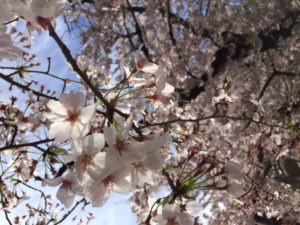3rd May 2017 Tokyo, Japan
Cherry blossom diplomacy

Everyone knows that Japan is famous for its cherry blossoms or “Sakura”. The subtle delicacy of the individual blooms, which collectively add up to a soft mass of pink that daubs the country at this time of year, are very special. But non-Japanese may not be quite as familiar with the very important role that cherry blossom viewing parties “hanami kai” play in Japanese life.
Japan is a country that has very distinct seasons, and the Japanese people are highly attuned to the changes in their natural surroundings through the year. April is the time when the new school year starts, like September in Britain, and it’s also when Japanese workers tend to transfer jobs. Around 900,000 new graduate recruits began their first job on 3 April this year.
So with all this change going on there are lots of hellos and goodbyes to be said. And how better to do it than as part of a cherry blossom party. All over the country, friends and colleagues gather under the shelter of a sakura in full blossom, for a glass of sake. The embassy in Tokyo is no exception. I hosted several hanami kai over the course of a week or so, for each of the various Embassy teams’ contacts. For the political one we had over 30 ministers and MPs attending.

We are fortunate that our Embassy has one of the most famous collections of cherry blossoms in Tokyo. They were planted by one of my predecessors, Sir Ernest Satow, who was head of this mission from 1895-1900. I’m particularly interested in Satow, as by a strange coincidence, when he retired from diplomatic life, he spent the last 20 years of his life in the small town in Devon where I grew up.
When HRH the Duke of Cambridge visited Japan in 2015, he planted a rare “Great White” cherry in the Embassy grounds. This was a native species which had become extinct in Japan until it was re-introduced from the UK by the eminent British botanist Collingwood Ingram in 1932.
The cherry blossoms have waned now, hastened by April showers. But as usual, we are all grateful for the fleeting sense of fragile beauty they brought into our lives for a few days.
I am writing a book on the history of the cherry tree and am interested in more details about gifting of cherry trees. I recently spent some time in the Tamar Valley Devon where several people are reviving old cherry species. I am interested in more information on Sir Satow